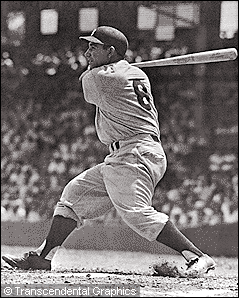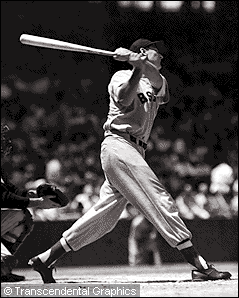



| The playing field | Additional definitions & Information |
| Objectives of the game | Legal pitching delivery |
| How the game is played | Statistics |
| The Runner | Results by Year |
The field shall be laid out according to the instructions below.
The infield shall be a 90-foot square. (Youth leagues use a 60-foot square.)The outfield shall be the area between two foul lines formed by extending two sides of the square from home plate. The distance from home base to the nearest fence, stand or other obstruction on fair territory shall be 250 feet or more. A distance of 320 feet or more along the foul lines, and 400 feet or more to center field is preferable. The infield shall be graded so that the base lines and home plate are level. The pitcher's plate shall be 10 inches above the level of home plate and 60 feet 6 inches from home plate (Youth leagues use 46 feet.) The degree of slope from a point 6 inches in front of the pitcher's plate to a point 6 feet toward home plate shall be 1 inch to 1 foot, and such degree of slope shall be uniform. The infield and outfield, including the boundary lines, are fair territory and all other area is foul territory.
The ball is a sphere formed by yarn wound around a small core of cork, rubber or similar material, covered with two stripes of white horsehide or cowhide, tightly stitched together. It weighs 5 1/4 ounces avoirdupois and is 9 1/4 inches in circumference.
The bat is a smooth, round stick not more than 2 3/4 inches in diameter at the thickest part and not more than 42 inches in length. The most common length used is 35 inches.
Each fielder, may use or wear a leather glove. A FIELDER is any defensive player.
The objective of each team is to win by scoring more runs than the opponent.
A RUN (or SCORE) is the score made by an offensive player who advances from batter to runner and touches first, second, third and home bases in that order. The order of the bases is in a counter-clockwise direction around the square from home to first, etc.
A BATTER is an offensive player who takes his position in the batter's box and attempts to hit a ball thrown to him by the pitcher. A PITCHER is the fielder designated to deliver the pitch to the batter. The pitcher pitches the ball to the batter and the batter attempts to hit the pitch and become a runner. The defense attempts to catch the ball after it is hit and put the batter and/or runners out.
A PITCH is a ball delivered to the batter by the pitcher.
The CATCHER is the fielder who takes his position back of the home base and catches the pitcher's pitch when the batter does not hit the pitch.
A RUNNER is an offensive player who is advancing toward, or touching, or returning to any base.
The winner of the game shall be that team which shall have scored, in accordance with these rules, the greater number of runs at the conclusion of a regulation game.
A regulation game consists of nine INNINGS, unless extended because of a tie score, or shortened (1) because the home team needs none of its half of the ninth inning or only a fraction of it.
If the score is tied after nine completed INNINGS play shall continue until (1)the visiting team has scored more total runs than the home team at the end of a completed inning, or (2) the home team scores the winning run in an uncompleted inning.
An INNING is that portion of a game within which the teams alternate on offense and defense and in which there are three OUTS for each team. Each team's time at bat is a half-inning.
An OUT is one of the three required retirements of an offensive team during its time at bat.
When three offensive players are legally put out, that team takes the field and the opposing team becomes the offensive team.
One run shall be scored each time a runner legally advances to and touches first, second, third and home base before three men are put out to end the inning.
EXCEPTION: A run is not scored if the runner advances to home base during a play in which the third out is made (1) by the batter-runner before he touches first base; (2) by any runner being forced out; or (3) by a preceding runner who is declared out because he failed to touch one of the bases.
The players of the home team shall take their defensive positions, the first batter of the visiting team shall take his position in the batter's box, the umpire shall call "Play" and the game shall start.
When the ball is put in play at the start of, or during a game, all fielders other than the catcher shall be on fair territory.
The batting order shall be followed throughout the game unless a player is substituted for another. In that case the substitute shall take the place of the replaced player in the batting order.
Each player of the offensive team shall bat in the order that his name appears in his team's batting order.
The first batter in each inning after the first inning shall be the player whose name follows that of the last player who legally completed his time at bat in the preceding inning.
A batter has legally completed his time at bat when he is put out or becomes a runner.
A batter may be put out in any of the following ways -
The batter becomes a runner and is entitled to first base without liability to be put out when -
The batter becomes a runner and is liable to be put out when -
A runner acquires the right to an unoccupied base when he touches it before he is put out. He is then entitled to it until he is put out, or forced to vacate it for another runner legally entitled to that base.
In advancing, a runner shall touch first, second, third and home base in order. If forced to return, he shall retouch all bases in reverse order, unless the ball is dead under any provision of Rule 5.09. In such cases, the runner may go directly to his original base.
Two runners may not occupy a base, but if, while the ball is alive, two runners are touching a base, the following runner shall be out when tagged. The preceding runner is entitled to the base.
Each runner including the batter-runner may, without liability to be put out, advance - To home base, scoring a run, if a fair ball goes out of the playing field in flight and he touched all bases legally; This is called a HOMERUN
Any runner is out when -
First base and home may be overrun, second and third may not.
The BATTER'S BOX is the area within which the batter shall stand during his time at bat.
The BATTERY is the pitcher and catcher.
A DEAD BALL is a ball out of play because of a legally created temporary suspension of play.
The DEFENSE (or DEFENSIVE) is the team, or any player of the team, in the field.
A FORCE PLAY is a play in which a runner legally loses his right to occupy a base by reason of the batter becoming a runner.
A GROUND BALL is a batted ball that rolls or bounces close to the ground.
An INFIELDER is a fielder who occupies a position in the infield.
IN FLIGHT describes a batted, thrown, or pitched ball which has not yet touched the ground or some object other than a fielder.
OFFENSE is the team, or any player of the team, at bat.
An OUTFIELDER is a fielder who occupies a position in the outfield, which is the area of the playing field most distant from home base.
"SAFE" is a declaration by the umpire that a runner is entitled to the base for which he was trying.
After the ball is dead, play shall be resumed when the pitcher takes his place on the pitcher's plate with a new ball or the same ball in his possession and the plate umpire calls "Play." The plate umpire shall call "Play" as soon as the pitcher takes his place on his plate with the ball in his possession.
There are two legal pitching positions, the Windup Position and the Set Position, and either position may be used at any time.
Team | League | Total | Year |
New York Yankees | AL | 26 | 1923, '27, '28, '32, '36, '37, '38, '39, '41, '43, '47, '49, '50, '51, '52, '53, '56, '58, '61, '62, '77, '78, '96, '98, '99, 2000 |
St. Louis Cardinals | NL | 9 | 1926, '31, '34 '42, '44, '46, '64, '67, '82 |
Boston Red Sox | AL | 6 | 1903, '12, '15, '16, '18, 2004 |
New York Giants | NL | 5 | 1905, '21, '22, '33, '54 |
Philadelphia Athletics | AL | 5 | 1910, '11, '13, '29, '30 |
Pittsburgh Pirates | NL | 5 | 1909, '25, '60, '71, '79 |
Los Angeles Dodgers | NL | 5 | 1959, '63, '65, '81, '88 |
Cincinnati Reds | NL | 5 | 1919, '40, '75, '76, '90 |
Detroit Tigers | AL | 4 | 1935, '45, '68, '84 |
Oakland Athletics | AL | 4 | 1972, '73, '74, '89 |
Baltimore Orioles | AL | 3 | 1966, '70, '83 |
Chicago White Sox | AL | 3 | 1906, '17, 2005 |
Chicago Cubs | NL | 2 | 1907, '08 |
Cleveland Indians | AL | 2 | 1920 '48 |
Minnesota Twins | AL | 2 | 1987, '91 |
New York Mets | NL | 2 | 1969, '86 |
Toronto Blue Jays | AL | 2 | 1992, '93 |
Florida Marlins | NL | 2 | 1997, 2003 |
Atlanta Braves | NL | 1 | |
Boston Braves | NL | 1 | 1914 |
Brooklyn Dodgers | NL | 1 | 1955 |
Milwaukee Braves | NL | 1 | 1957 |
Philadelphia Phillies | NL | 1 | 1980 |
Kansas City Royals | AL | 1 | 1985 |
Washington Senators | AL | 1 | 1924 |
Anaheim Angels | AL | 1 | 2002 |
Arizona Diamondbacks | NL | 1 | 2001 |